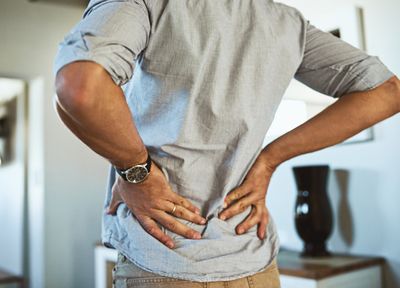
How To Look After Your Back
Reassess Your Work Set Up
Whether you’re in the office or working from home, it’s essential to have an adequate work setup to keep your back supported throughout the day. “Back pain is the most common thing I see in my clinics, and over the last few months many people have been experiencing new and worsening back pain due to working from home and being less active during lockdown,” explains Dr Rahul Lakhera, GP at OneMedical Group. “If you’re working in the office, get a proper health and safety assessment of your work setup to ensure everything is aligned in the right position so you can maintain correct posture at your desk. Throughout the day, check in with yourself and think about what position you’re in and whether it’s causing pain or tension – if you’re working from home, this is even more vital as you’re probably working from a makeshift desk space. It’s also incredibly important to take regular breaks and stetch the body when you can – a minute of lunges every hour is a good exercise to try.”
Jayden Arnold, consultant physiotherapist at Ten Health & Fitness, agrees: “Having the right equipment in the workspace is key. The most important piece of equipment for your back is an adjustable desk chair that can lock the sitting position of the back. A desk with sufficient space for you to relax your forearms on is also essential, while a footrest can provide extra comfort.” Ensure your screen is in the correct position (the top should be at eye level) and if it’s too low, elevate it. “A thick book or yoga block will do the trick,” says Jayden.
Improve Your Posture
To maintain optimum back health, you’ll need to actively improve your posture. “Seated posture is important because correct spinal alignment ensures your muscles are in the most efficient position possible,” says Jayden. “The correct posture will reduce the demand on your back muscles and your bodyweight will be evenly distributed throughout the body. When muscles get sore, it’s because they are having to work too hard in one position. The body is designed for motion not inaction, so stretching regularly throughout the day will make a big difference.”
To strengthen the back and promote good posture, you also need to have a strong core, says Pilates instructor Nathalie Clough. “As men are generally taller than women, their centre of gravity is higher, so they need a strong core to have good posture.” Pilates is a great way to help strengthen this, explains Nathalie. “It changes the posture of the body and strengthens the core, meaning you’ll be able to sit up straight and alleviate pressure from the spine.”
Exercise Regularly
Building shoulder and back strength will ensure muscles don’t get sore from being in seated positions. One of the best ways to achieve this is regular, sustained exercise. A physio can prescribe exercises for specific concerns, but when it comes to working out, Pilates is a great all-rounder. “Generally, men focus on weights and building muscle in their workouts, which actually tightens the body and puts strain on the back, so it’s important to mix up your routine and add in some Pilates and stretching exercises,” says Nathalie. “Equally, doing nothing for a while and then jumping straight into an intense session, like a HIIT workout, can also put added stress on your joints, so make sure you work out regularly to keep things moving.” Nathalie also highlights the importance of weight and nutrition. “Watching what you eat and drink is incredibly important. A beer belly can put strain on the back, particularly if your core is weak, so if you’re having back problems, losing a few pounds should be one of the first things you consider before seeking professional help.”
Stretch, Then Stretch Again
Alongside regular exercise, stretching the body is key. “Men generally have tighter muscles than women,” says Nathalie. “Stretching the legs, hips and glutes can help alleviate tightness in the back, so aim to incorporate this into your daily routine, not just before and after working out. Ten to 20 minutes of gentle stretching or Pilates every day can have a significant impact on improving the way you feel both physically and mentally. A quick stretch during spare moments, like when you’re watching TV or having a phone call, will make a big difference.”
Sammy Margo, physiotherapist and advisor at Mind Your Back UK, agrees: “Gentle stretching will help improve your mobility and posture. Wherever you are, aim to move around from a seated position every 30 minutes or so, or try a quick stretching exercise. A spinal stretch, back rotation and flex stretch (similar to a cat stretch in yoga, but against a desk) can all help alleviate tension.”
Stay Hydrated
“Dehydration isn’t often associated with back pain, but it’s one of the most important things to stay on top of,” says Nathalie. “When we don’t drink enough water, the discs in our spine can shrivel up and pull away from the vertebrae, resulting in tension and pain. Our discs need to be bouncy as they support vertebrae on either side of the body; if they dry up, it can cause pressure on the lower back. Aim to drink between six and eight glasses of water a day.”
Get Your Back Checked
Looking after your back will help prevent aches, pains and tension, but if you’re having problems, seek professional help. “In most cases, lower back pain is easily treatable and short-lived, and the pain usually stems from postural weaknesses that put too much pressure on our spine,” explains osteopath Hannah Williams. “However, in rare circumstances, back pain can also be a symptom of something more serious, so it’s always worth seeking professional advice for any aches and pains. Osteopaths specialise in the diagnosis and treatment of lower back pain and sciatica (when the sciatic nerve becomes trapped or irritated) and will be able to give you a detailed diagnosis. Osteopaths are also experts at spotting more serious illnesses related to back issues, such as certain cancers and neurological conditions which can present as simple aches and pains.”
If you’ve been referred to an osteopath, a consultation usually begins with a physical examination and a discussion about the history of your pain or injury, and you’ll be asked general lifestyle questions before they reach a diagnosis. “You may be shown different techniques such as joint articulation and manipulation to help correct any areas of restricted movement in the spine, hips or pelvis. They can also recommend massages and stretching techniques to ease tight muscles, improve circulation and rehabilitate old injuries,” says Hannah. “An osteopath will work with you to develop a personalised home-exercise programme that will reduce the risk of your back pain recurring, and help manage chronic symptoms.”
Ready to stretch it out? Here are NatHalie Clough’s top six exercises and stretches to try at home…
1. Shoulder Bridge
Reps: 5-10
Set Up: Lie on your back with knees bent and feet flat near your bottom. Position your arms down by your sides.
Action: Press your arms, shoulders and back into the floor. Tip your hips gently towards you, reducing the space behind the lower back. Keep tipping your hips as you peel your spine, vertebrae by vertebrae, off the floor. Stop when your hips are lifted off the floor and you have an even line from your knees to your shoulders. Slowly roll back down from the upper back to the lower back. Ensure the lower back isn’t arched at the top.
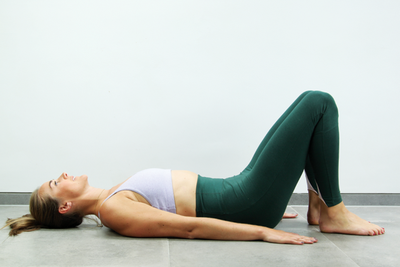
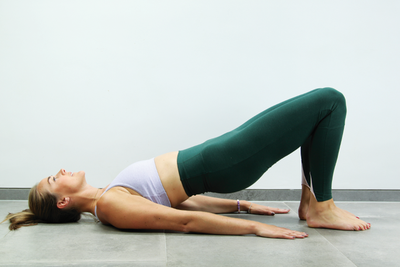
2. Single Leg Stretch
Reps: 10-20
Set Up: Lie on your back with knees bent into your chest, and your head down. Curl the head, neck and shoulders up to look into the belly.
Action: Put your hands onto one shin, pulling it tight into the body, and extend the opposite leg away. Swap the legs and hands over, and pull the leg in tight towards the body. Keep looking at the belly throughout. Ensure the extended leg doesn’t go too low – keep it high if the back aches.
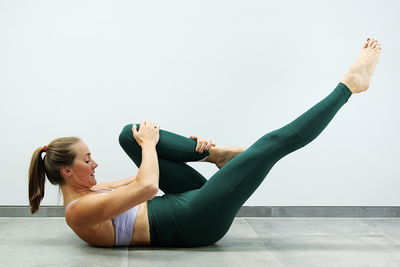
3. Hamstring Stretch
Reps: Hold for 30 seconds and repeat on the other side.
Set Up: Lie on your back with knees bent and feet flat. Then bring one leg into the chest and extend it up to the ceiling.
Action: Hold the back of your leg and press it into your hands. Make sure your tailbone doesn't lift away from the mat and that your ribs do not arch. For a deeper stretch, extend the foot on the floor.
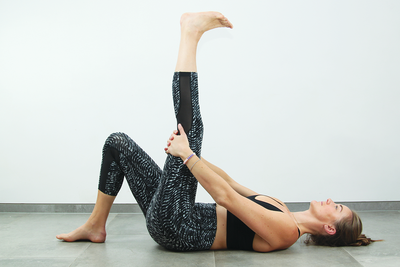
4. IT Band Stretch
Reps: Hold for 30 seconds and repeat on the other side.
Set Up: Lie on your back, with your right leg extended and your left up to the ceiling.
Action: Hold the side of your left leg with your right hand and draw it gently across your body. At the same time, hold your left hip down with your left hand, keeping it close to the floor. Make sure your shoulders don't lift from the mat and that your ribs do not arch. You can combine this with the hamstring stretch.
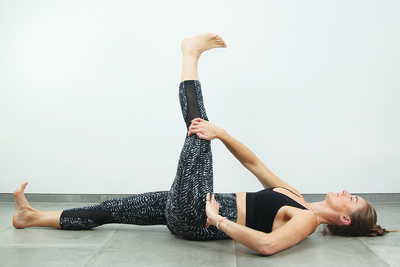
5. Hip Flexor Stretch
Reps: Hold for 30 seconds and repeat three times.
Set Up: Start in a kneeling position with one foot out in front, keeping the knee in line with the spine. Place your hands on your hips, sit up straight, and pull your abs in.
Action: Use the hands as a guide to tip your hips backwards and your pubic bone forwards, encouraging a stretch through the front of the hip with the knee on the floor. Don't sink into the lower back and compress the spine – think tall and long.
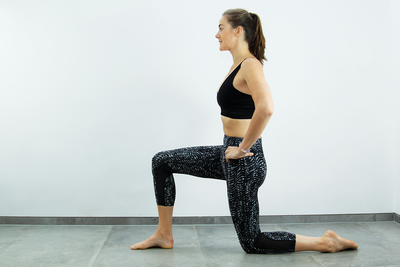
6. Glute Stretch
Reps: Hold for 30 seconds and repeat three times.
Set Up: Lie on your back, bring your right ankle over your left knee and hold onto the back of your left thigh.
Action: Pull your left leg gently towards you and keep your shoulders, back and bottom on the floor. Open your right knee out to the side. Ensure your tailbone doesn’t lift upwards, and if your neck lifts upwards, place a cushion underneath it.
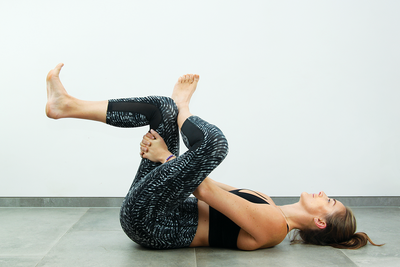
*DISCLAIMER: Features published by SLMan are not intended to treat, diagnose, cure or prevent any disease. Always seek the advice of your GP or another qualified healthcare provider for any questions you have regarding a medical condition, and before undertaking any diet, exercise or other health-related programme.
DISCLAIMER: We endeavour to always credit the correct original source of every image we use. If you think a credit may be incorrect, please contact us at [email protected].